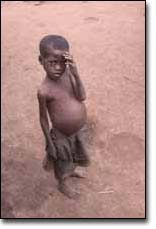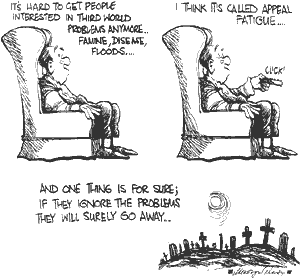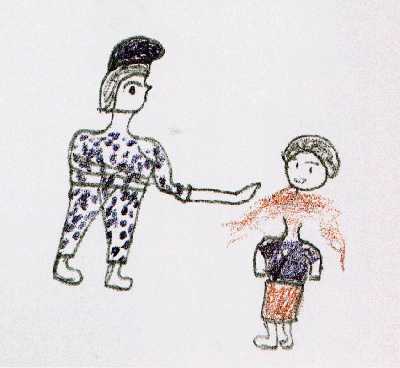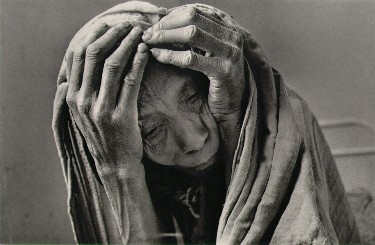AN332/CS310 - Week 4: Journalism and the
Majority World - September 30, 2002
Topic: Reporting on Development and
Disaster
keywords:
. hunger pornography
. development narratives
. compassion fatigue
. news values
media material:
. foreign news stories
. testimonials from Worldvision
1. Media Representation of Development: The Problem of Hunger
Pornography
reading: Jonathan Benthall. Chapter 5, "Images and Narratives of Disaster
Relief." Disasters, Relief, and the Media. New York: I.B. Tauris and
Co., 1993. 44 pages.

from the Worldvision site, southern Africa campaign, 2002
. today we are concerned with how the media represent both development
stories, and more generally, the third world as defined in terms of social and
natural disasters
a. the problem of hunger pornography
. development and relief agencies (e.g., CUSO, CARE, WorldVision) find
themselves in contradiction when using advertising and public relations
techniques to represent the Third World, since these techniques bear the residue
of their origins in commercial, for-profit media
. this means that the humanitarian purpose and the logic of media are often
at odds with each other, insofar as this famine or that war child begins to
resemble a product or package to be sold to Western audiences
. the problem of what is often called hunger or disaster "pornography" - the
exploitative representation of people unable to represent themselves, e.g. the
starving wide-eyed children in so many ads for Third World charities - has been
a particular symptom of this tension between philanthropy and profit
. such hunger porn was common from the early 20th century to the
early 1980s, and amplified by the use of photo-journalism, and later,
television, and is similar in nature to the pornography that commonly features
women, e.g., Playboy, in Western culture
. both forms of "porn" - here defined as media offering explicit, intimate
representations of people who have little to no control over the terms of that
representation (compare with "erotica") - colonize the persons captured in the
image, and grant significant control to the person behind the camera, reading
the centerfold, or watching TV
. control of the image - through our comfortable reception of it - implies
control over the person or people, and the potential threat (to our conscience,
our way of life, etc.) they also represent
. since about 1980, development agencies have begun to draft principles re.
the proper representation of Third World peoples, reflecting their concern to be
less exploitive (Benthall lists a number of these principles)
b. narrative theory and the "development narrative"
. Benthall is interested in the kind of stories the media tell us as they
represent the Third World to us in telethons, ads, infomercials, newscasts,
etc.
. given the complexity of issues and problems there, a story (or "narrative",
to use the technical term) is necessary to allow the viewer to relate to the
situation (and potentially donate money)
. using a form of literary and communications criticism called narrative
theory, Benthall identifies some of the basic features of the "development
narrative" (i.e., the story that we are continually told about development and
the nature of the majority world's problems in the media)
. the features Benthall outlines below (and that I have filled in with other
material) are apparent in media representation of development even
after the hunger pornography thought to end as of roughly 1980
. these features are not unique to development narratives, but they are
especially relevant and active in them
c. basic features of the "development narrative":
- "clawback": the phenomenon of "clawback" (Fiske and
Hartley), which acts to control deviant interpretations that we might give to
the narrative, and makes our reading of it conform to the "ideological" or
dominant reading implied in the text, i.e., the "right way" to understand what
is happening in the ad, infomercial, newscast, etc.; "clawback" is common to
many media forms, and is a basic function of ideology
- "invisibility of structure": the narrative convention of
focussing on one or several people, e.g., a mother and child, thereby
individualizing a problem with hidden social and structural dimensions
- the "transparency fallacy": whereby the medium seems so
powerful in delivering a distant and different reality to us, that we feel
that we are really there and experiencing the problems, the people, and the
culture as they truly are (where in fact we are not)
- the "technology of enchantment" or "magic helper"
phenomenon: whereby the act of seeing something on TV, e.g., a
telethon for a development cause, absolves us of our guilt - we feel that to
watch is to participate and to act - that by watching we have done something
- media as "transitional objects": media - especially TV -
serve as "transitional objects" (a toy or keepsake that serves as a mother
substitute, e.g., like Linus' blanket in Peanuts), insofar as their
task is to assuage or relieve us of our stress and anxiety; hence development
narratives tend not to disrupt our comfortable existence in First World and
arguably thereby have less effect; stories are told in such a way as to not
upset the "fragile political construct" that is our affluent tranquillity here
in the West
- "secondary orality": concept developed by communications
scholar Walter J. Ong; secondary orality is the manifestation of oral culture
in electronic media, e.g., on-air commentary by announcers, actors in TV
shows, etc.; oral speech allows for ready identification with the speaker and
is very intimate and compelling, yet on TV it is scripted, and thereby allows
for ideological power not possible in improvised, ordinary oral speech
2. Media Representation of Disaster: The Problem of Compassion
Fatigue
From Susan Moeller. Chapter 1, "Compassion Fatigue." Compassion Fatigue:
How the Media Sell Disease, Famine, War and Death.

a. what is compassion fatigue?
definition:
Compassion fatigue is the moral exhaustion which people (typically in the
West) experience after regular exposure to media coverage of humanitarian
disasters of natural or human origin (earthquake, flood, famine, war) in the
majority world. The ultimate result is a desensitization to the problems the 70%
of the world's population that lives in the majority world faces, and a
political and moral disengagement with the world.
b. how are print and television media implicated in creating
compassion fatigue?
- we need to appreciate that our sense of what the third world is about
derives in large measure both from the content of news in newspaper and
television, but also from the formal properties of news (i.e., how is a story
told), professional practices and culture (e.g., how journalists do their
work) and news values (i.e., what defines something as newsworthy) that
(i) news content
- one story at a time: the regular reportage of bad news
stories from the third world overwhelms our capacity to absorb such stories;
it's believed that we have attention span for one major story about Europe or
the third world at a given time
- Americans involved? unless Americans (or if the audience
is Canadian or European, them) are involved in the story in some way, it is
difficult to attract and hold American attention for a given story
- binary morality: the media needs to reduce the moral
complexity of real people and their problems to a simple "black and white"
moral code, in which we are certain who is good and who is bad, e.g., good
doctors saving lives, bad rebels recruiting children as soldiers, etc.
- shock value: in order for the media to break through our
growing numbness with respect to the problems of the world, they present us
with evermore shocking and graphic stories and images

image drawn by a child who survived the 1994 Rwandan genocide
(800,000 Tutsi killed)
. the result is a steady escalation of the shock value of stories, and
consequent greater trauma and numbness on the part of the Western audience,
e.g., how do we respond meaningfully to a massacre after the Khmer Rouge in
Cambodia (2 million dead) or the genocide in Rwanda and Burundi in the late
1990s
- imperial imagery and pop culture: coverage of third world
tends to be more sensationalistic, i.e., graphic, concerned for shock value,
because of the lasting effect of underlying myths with respect to primitive,
bizarre, and exotic nature of cultures in the majority world; in other words,
generations of Tarzan and Indiana Jones-type stories mean that Western
journalists and publics are disposed to see third world in those terms
- false analogies: we are constantly fed historical
analogies to help us understand a foreign news story, e.g., Saddam Hussein is
like Hitler; Afghanistan might be a quagmire like Vietnam, and we should not
get involved; but these historical analogies tend to reduce foreign stories to
historical cliches, and moreover are likely not to be valid as sources of
understanding
(ii) news and its formal properties
- formula and myth: the very nature of news is formulaic
and ritualized; we read endless stories about domestic economic news and
crime, and after regular exposure to these, the stories come to seem the same
. the formulaic nature of news follows from the fact that a newspaper or a TV
news hour must be reproduced every day without fail, and thus that stories must
continue to be produced on a regular, routine basis
. so as to make this possible, news stories (whether print or TV) are written
according to a formula that the journalist learns in journalism school and/or on
the job
. the formulaic nature of news derives from the inverted pyramid style (start
with the most general statement possible, e.g. Colombian guerillas attacked the
presidential palace, and then proceed to more and more specific and detailed
information), the use of highly conventional language (metaphor, formulaic
phrases), the structure of the journalist's beat and the use of the same, often
official and bureaucratic sources for news, etc.
. this same logic then holds true for international news, and thus each
famine, war, or other disaster seems the same as the others that preceded it
. we need to appreciate just how "mythological" the nature of news is,
insofar as myths are stories that are told and retold to the point where they
lose any specific historical origin or detail they might have had, and come to
seem timeless and universal, e.g., the myth of Adam and Eve in Christian
tradition, the myth of Santa Claus (there was a real St. Nicholas)
. the news becomes mythic when each story about a scandal, a crime, a
celebrity or a scientific discovery seems to speak for all such stories, and
thus draw upon what appears to be some universal or lasting truth about scandal,
crime, celebrity, science, etc.
. the result is that we don't pay attention to the details, but rather have
some ideological sense of how the world works confirmed for us, e.g., it is the
destiny of people in the third world to suffer, we can do nothing, they brought
the war or famine onto themselves, the world is a bad place, etc.
- American cultural references: if American (or European)
cultural references or icons are present (or an American celebrity, such as an
actor or rock star), it is more likely that Western audiences will pay
attention and understand the issues, e.g., the Chinese students at Tiananmen
Square and their use of the Statue of Liberty as a symbol; the use of B-actors
in telethons or infomercials for third world charities
- shrinking newshole: what is called the "newshole" (i.e.,
the space that a newspaper or a TV news show must fill) is steadily shrinking
with respect to foreign news; in 1989, the 3 major U.S. networks created 4,032
minutes of foreign news, while in 1995 the same 3 created only 1991 minutes,
reflecting what they felt was declining U.S. audience interest in foreign news
- shrinking story length: the average length of newspaper
stories and TV news segments is shrinking too, and is now 700-900 words for a
newspaper story, and 80 seconds for a TV story; this means that stories are
simpler, lack context, rely on stereotypes and cliches to communicate point
quickly
(iii) journalists' professional practices and culture
- costs: the costs of foreign coverage are very high,
compared to domestic news coverage, with the result that there are few foreign
correspondents posted outside North America, e.g., there were only 400 foreign
correspondents working for major U.S. newspapers in 1995, and a number of
these were posted in Europe
- casualty rate: there is great competition for the most
powerful pictures and often in the most dangerous situations, with the result
that the death rate of foreign correspondents is high
- American interests there? unless there are American (or
First World) interests in a given country, whether these are historical
interests (e.g., a former colony), strategic, or economic, it is much less
likely that a story there will be covered, e.g., of how 35% of international
stories in U.S. are about Middle East, a world area that has only 5% of the
world's population, but is strategically important to the U.S. because of its
oil reserves and U.S.'s strong affiliation with Israel
- race: if the people in a particular non-Western country are white,
e.g., eastern Europe, it is more likely that the story will be covered, since
it is believed that Western audiences identify more with white rather than
non-white people
- parachute journalism: foreign coverage tends to be
"parachute journalism," insofar as journalists enter a given country quickly
to cover some crisis, and then just as quickly leave to go to the next story;
the result is a lack of context, follow-up, or understanding of the story in
any detail
- voice-over journalism: much foreign coverage is purchased
from freelance journalists; networks and news agencies like Reuters or
Associated Press buy stories or video footage, and then add their own
voice-overs (Moeller refers to this as "voice-over" journalism); such
"voice-over" journalism dubbed into video footage is not very well-informed,
as journalist doing voice-over was not present at the story, and is relying on
whatever research has been provided to her or him
- military censorship: major international news stories,
e.g., Persian Gulf War, attack on World Trade Centre and Pentagon, are managed
carefully by first world governments with a stake in the issue; with respect
to Persian Gulf War, journalists were carefully controlled by Pentagon, and
the result was a view of that war as defined by the U.S. military
(iv) news values (i.e., what makes something
newsworthy)
- the newsworthiness of a given story typically must meet most of
the following criteria (taken verbatim from Moeller, p. 17)
timeliness: Did the event just happen?
proximity: How close is the event, physically and
psychologically?
significance: How many people have some knowledge or interest in the
event?
controversy: Is there conflict or drama?
novelty: Is the event unusual?
currency: Is the event part of an ongoing issue?
emotional appeal: Is there humour, sadness, or a thrill?
images: Are there good pictures?
- many stories in the majority world do not meet these criteria,
with the result that many international stories go uncovered
c. how are images implicated in compassion fatigue?

image from Mali, Africa
- suffering sells: journalists know that "suffering sells," and that
the images that convey the most emotional pain and trauma are those that
editors will use in print and TV news; the result is that many foreign news
stories are reduced to the anguish of a particular person or persons, and this
tends to depoliticize the actual event
- pain and advertising: as pain is showcased in this way, wedged
between ads for soap and candy bars, the result is that someone's pain becomes
a form of entertainment, and thus loses it integrity
- good pictures? if a foreign news story does not generate good
pictures - whether for print or TV sources - it is less likely that it will be
covered, printed, or aired, regardless of how important the story is
- emotion and reason: powerful images evoke a two-part response on
the reader or viewer's part: we are first emotionally overwhelmed; and then
respond with a rational argument that there is little we can do, and therefore
must turn the page or change the channel; the result is that we bear witness
to an event, but we are not inclined to help
- codes and cliches: images often conform to codes and cliches,
insofar as the shots are composed by photographers and camera operators who
want to ensure that the audience gets the message; hence a starving child in
her mother's arms becomes the image of famine; a gun-toting guerilla in
camouflage gear becomes the image of coup, etc.
- complexity: images cannot communicate ideas effectively, and thus
are limited insofar as we are concerned to report on complex issues; as
Moeller says, "You cannot take a picture of an idea."
- ideology: images live much closer to ideology (i.e., a culture's
governing ideas, themes, beliefs, etc.) than do words, and the result is that
images convey ideology in powerful ways; words give us a measure of distance
from the message, while images plunge us into the meanings assembled
there
- captions: images are typically combined with captions, labels, and
other verbiage that guides our emotional response to the image
- context, cause, and history: images necessarily simplify complex
stories, and do not communicate context, cause, or history well
- visual literacy: Western audiences are not "visually literate,"
and the result is that we interpret images on a naive basis




